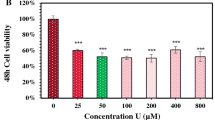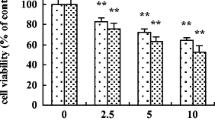Abstract
Ur anium release into the environment is a threat to human health, and the mechanisms of cytotoxicity caused by uranium are not well-understood. To improve our understanding in this respect, we herein evaluated the effects of uranium exposure on normal rat hepatic BRL cells. As revealed by scanning electron microscopy and transmission electron microscope analysis, uranyl nitrate was found to be transformed into uranyl phosphate particles in the medium and taken up by BRL cells in an endocytotic uptake manner, which presumably initiates apoptosis of the cell, although soluble uranyl ion may also be toxic. The apoptosis of BRL cells upon uranium exposure was also confirmed by both the acridine orange and ethidium bromide double staining assay and the Annexin V/propidium iodide double staining assay. Further studies revealed that uranium induced the loss of mitochondrial membrane potential in a dose-dependent manner. Moreover, the uranium-induced apoptosis was found to be associated with the activation of caspase-3, caspase-8 and caspase-9, indicating both a mitochondria-dependent signaling pathway and a death receptor pathway by a crosstalk. This study provides new chemical and biological insights into the mechanism of uranium toxicity toward hepatic cells, which will help seek approaches for biological remediation of uranium.







Similar content being viewed by others
References
Angenard G, Muczynski V, Coffigny H, Duquenne C, Frydman R, Habert R, Livera G, Rouiller-Fabre V (2011) In vitro effects of Uranium on human fetal germ cells. Reprod Toxicol 31(4):470–476
Belosludtsev KN, Garmash SA, Belosludtseva NV, Belova SP, Berezhnov AV, Gudkov SV (2012) Study of the mechanisms of cytotoxic effect of uranyl nitrate. Biofizika 57(5):789–795
Carrière M, Avoscan L, Collins R, Carrot F, Khodja H, Ansoborlo E, Gouget B (2004) Influence of uranium speciation on normal rat kidney (NRK-52E) proximal cell cytotoxicity. Chem Res Toxicol 17(3):446–452
Carrière M, Gouget B, Gallien J, Avoscan L, Gobin R, Verbavatz J, Khodja H (2005) Cellular distribution of uranium after acute exposure of renal epithelial cells: SEM, TEM and nuclear microscopy analysis. Nucl Instrum Methods Phys Res B 231(1–4):268–273
Carrière M, Thiebault C, Milgram S, Avoscan L, Proux O, Gouget B (2006) Citrate does not change uranium chemical speciation in cell culture medium but increases its toxicity and accumulation in NRK-52E cells. Chem Res Toxicol 19(12):1637–1642
Carrière M, Proux O, Milgram S, Thiebault C, Avoscan L, Barre N, Auwer CD, Gouget B (2008) Transmission electron microscopic and X-ray absorption fine structure spectroscopic investigation of U repartition and speciation after accumulation in renal cells. J Biol Inorg Chem 13(5):655–662
Chiruvella KK, Kari V, Choudhary B, Nambiar M, Ghanta RG, Raghavan SC (2008) Methyl angolensate, a natural tetranortriterpenoid induces intrinsic apoptotic pathway in leukemic cells. FEBS Lett 582(29):4066–4076
Gorden AE, Xu J, Raymond KN, Durbin P (2003) Rational design of sequestering agents for plutonium and other actinides. Chem Rev 103(11):4207–4282
Guicciardi ME, Malhi H, Mott JL, Gores GJ (2013) Apoptosis and necrosis in the liver. Compr Physiol 3(2):977–1010
Heintze E, Aguilera C, Davis M, Fricker A, Li Q, Martinez J, Gage MJ (2011) Toxicity of depleted uranium complexes is independent of p53 activity. J Inorg Biochem 105(2):142–148
Kalinich JF, Ramakrishnan N, Villa V, McClain DE (2002) Depleted uranium-uranyl chloride induces apoptosis in mouse J774 macrophages. Toxicology 179(1–2):105–114
Kantari C, H Walczak (2011) Caspase-8 and bid: caught in the act between death receptors and mitochondria. Biochim Biophys Acta 1813(4):558–563
Kopacek J, Ondrias K, Sedlakova B, Tomaskova J, Zahradnikova L, Sedlak J, Sulova Z, Zahradnikova A, Pastorek J, Krizanova O (2009) Type 2 IP(3) receptors are involved in uranyl acetate induced apoptosis in HEK 293 cells. Toxicology 262(1):73–79
Kurttio P, Auvinen A, Salonen L, Saha H, Pekkanen J, Mäkeläinen I, Väisänen SB, Penttilä IM, Komulainen H (2002) Renal effects of uranium in drinking water. Environ Health Perspect 110:337–342
Li J, Yuan J (2008) Caspases in apoptosis and beyond. Oncogene 27(48):6194–6206
Li X, Jin N, Mi Z, Lian H, Sun L, Li X, Zheng H (2006) Antitumor effects of a recombinant fowlpox virus expressing Apoptin in vivo and in vitro. Int J Cancer 119(12):2948–2957
Lin YW, Liao LF (2011) Probing interactions between uranyl ions and lipid membrane by molecular dynamics simulation. Comput Theo Chem 976(1–3):130–134
Markich SJ (2002) Uranium speciation and bioavailability in aquatic systems: an overview. Sci World J 2:707–729
Michon J, Frelon S, Garnier C, Coppin F (2010) Determinations of uranium(VI) binding properties with some metalloproteins (transferrin, albumin, metallothionein and ferritin) by fluorescence quenching. J Fluoresc 20(2):581–590
Miller AC, Stewart M, Brooks K, Shi L, Page N (2004) Depleted and natural uranium: chemistry and toxicological effects. J Toxicol Environ Health B Crit Rev 7:297–317
Mirto H, Henge-Napoli MH, Gibert R, Ansoborlo E, Fournier M, Cambar J (1999) Intracellular behaviour of uranium(VI) on renal epithelial cell in culture (LLC-PK1): influence of uranium speciation. Toxicol Lett 104(3):249–256
Montavon G, Apostolidis C, Bruchertseifer F, Repinc U, Morgenstern A (2009) Spectroscopic study of the interaction of U(VI) with transferrin and albumin for speciation of U(VI) under blood serum conditions. J Inorg Biochem 103(12):1609–1616
Murray VS, Bailey MR, Spratt BG (2002) Depleted uranium: a new battlefield hazard. Lancet 360:s31–s32
Periyakaruppan A, Sarkar S, Ravichandran P, Sadanandan B, Sharma CS, Ramesh V, Hall JC, Thomas R, Wilson BL, Ramesh GT (2009) Uranium induces apoptosis in lung epithelial cells. Arch Toxicol 83(6):595–600
Priest ND (2001) Toxicity of depleted uranium. Lancet 357(9252):244–246
Ribble D, Goldstein NB, Norris DA, Shellman YG (2005) A simple technique for quantifying apoptosis in 96-well plates. BMC Biotechnol 5:12
Sanchez DJ, Belles M, Albina ML, Sirvent JJ, Domingo JL (2001) Nephrotoxicity of simultaneous exposure to mercury and uranium in comparison to individual effects of these metals in rats. Biol Trace Elem Res 84(1–3):139–154
Sun MH, Liu SQ, Du KJ, Nie CM, Lin YW (2014) A spectroscopic study of uranyl-cytochrome b 5/cytochrome c interactions. Spectrochim Acta A Mol Biomol Spectrosc 118:130–137
Thiebault C, Carrière M, Milgram S, Simon A, Avoscan L, Gouget B (2007) Uranium induces apoptosis and is genotoxic to normal rat kidney (NRK-52E) proximal cells. Toxicol Sci 98(2):479–487
Vidaud C, Gourion-Arsiquaud S, Rollin-Genetet F, Torne-Celer C, Plantevin S, Pible O, Berthomieu C, Quemeneur E (2007) Structural consequences of binding of UO2 2+ to apotransferrin: can this protein account for entry of uranium into human cells? Biochemistry 46(8):2215–2226
Wan B, Fleming JT, Schultz TW, Sayler GS (2006) In vitro immune toxicity of depleted uranium: effects on murine macrophages, CD4 + T cells, and gene expression profiles. Environ Health Perspect 114(1):85–91
Wan D, Liao LF, Zhao MM, Wu ML, Wu YM, Lin YW (2012) Interactions of uranyl ion with cytochrome b 5 and its His39Ser variant as revealed by molecular simulation in combination with experimental methods. J Mol Model 18(3):1009–1013
Wieser A, Vasilenko E, Aladova E, Fattibene P, Semiochkina N, Smetanin M (2014) Electron paramagnetic resonance measurements of absorbed dose in teeth from citizens of Ozyorsk. Radiat Environ Biophys 53(2):321–333
Xiang Y, Lu Y (2011) Using personal glucose meters and functional DNA sensors to quantify a variety of analytical targets. Nat Chem 3(9):697–703
Zhou B, Shi LF, Wang YS, Yang HX, Xue JH, Liu L, Wang YS, Yin JC, Wang JC (2013) Resonance light scattering determination of uranyl based on labeled DNAzyme-gold nanoparticle system. Spectrochim Acta A Mol Biomol Spectrosc 110:419–424
Acknowledgments
This study was supported by Natural Science Foundation of China (Nos. 21101091; 21171007), the construct program of the key discipline in Hunan province (No. [2011]76) and the developing program of science and technology of Hengyang city (No. 2013KJ17).
Author information
Authors and Affiliations
Corresponding authors
Rights and permissions
About this article
Cite this article
Liu, F., Du, KJ., Fang, Z. et al. Chemical and biological insights into uranium-induced apoptosis of rat hepatic cell line. Radiat Environ Biophys 54, 207–216 (2015). https://doi.org/10.1007/s00411-015-0588-3
Received:
Accepted:
Published:
Issue Date:
DOI: https://doi.org/10.1007/s00411-015-0588-3




